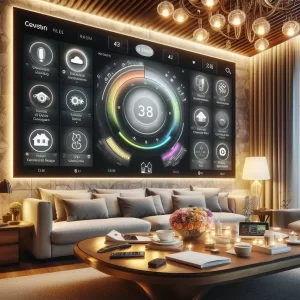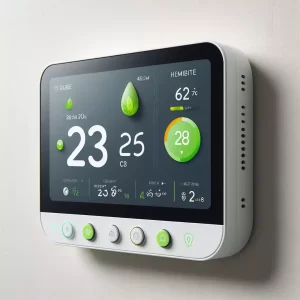Table of Contents

smart thermostats In today’s modern world, where technology has seamlessly integrated into our daily lives, smart thermostats stand out as revolutionary devices enhancing the way we manage home climate control. These intelligent gadgets have transformed traditional heating, ventilation, and air conditioning (HVAC) systems, offering unprecedented convenience, energy efficiency, and customization. Let’s delve into the myriad ways smart thermostats are redefining home climate control.

The Evolution of Thermostats
Gone are the days when manual thermostats reigned supreme, requiring constant adjustment and offering limited functionality. The advent of programmable thermostats marked the first significant leap, allowing homeowners to set schedules for temperature changes. However, the true game-changer emerged with the development of smart thermostats. These devices leverage advanced algorithms, connectivity, and user-friendly interfaces to provide a sophisticated climate control experience.
Energy Efficiency: A Green Revolution
One of the most compelling benefits of smart thermostats is their ability to significantly enhance energy efficiency. By learning your daily routines and preferences, these devices can optimize heating and cooling cycles to reduce energy consumption. For instance, a smart thermostat can automatically lower the temperature when you’re not home and raise it before you return, ensuring comfort without wasting energy.
Moreover, many smart thermostats provide detailed energy usage reports, enabling homeowners to monitor and adjust their habits. This transparency not only helps in reducing utility bills but also contributes to environmental sustainability. Imagine a world where every household optimizes its energy use – smart thermostats are a pivotal step towards that reality.
Seamless Connectivity: The Internet of Things (IoT)
The integration of smart thermostats into the Internet of Things (IoT) ecosystem has further elevated their functionality. These devices can communicate with other smart home gadgets, such as lights, security systems, and voice assistants. This interconnectedness allows for comprehensive automation. For example, when you lock your smart door, the thermostat can automatically switch to an energy-saving mode.
Voice control is another remarkable feature enabled by IoT connectivity. Imagine adjusting your home’s temperature simply by speaking a command to your smart speaker. This hands-free convenience exemplifies the futuristic capabilities of smart thermostats.
Enhanced User Experience
Smart thermostats are designed with the user in mind, offering intuitive interfaces and remote control capabilities. Through mobile apps, homeowners can adjust their home’s temperature from anywhere in the world. Whether you’re on vacation or stuck in traffic, you can ensure your home is at the perfect temperature upon your arrival.
These devices also come with sleek, modern designs that complement any home décor. With touchscreens, color displays, and customizable settings, smart thermostats are not only functional but also aesthetically pleasing. The user experience is further enriched by features like weather forecasts, which enable the thermostat to make informed decisions based on upcoming weather conditions.
Learning Capabilities: An Intelligent Approach
At the heart of smart thermostats lies their ability to learn and adapt. Using sensors and advanced algorithms, these devices gather data on your habits and preferences. Over time, they can predict your needs and adjust the climate accordingly. For instance, if you tend to lower the temperature before bedtime, the thermostat will eventually start doing this automatically.
This learning capability extends to occupancy detection as well. Smart thermostats can sense when a room is occupied and adjust the temperature accordingly, ensuring comfort only when needed. This not only enhances energy efficiency but also provides a personalized climate control experience.
Integration with Renewable Energy Sources
As renewable energy sources become more prevalent, smart thermostats play a crucial role in integrating these technologies into our homes. Many smart thermostats can be programmed to take advantage of peak renewable energy periods. For example, they can prioritize using solar power during sunny hours to heat or cool the home.
This synergy between smart thermostats and renewable energy sources not only reduces reliance on fossil fuels but also maximizes the benefits of green energy investments. It’s a harmonious blend of technology and sustainability, paving the way for an eco-friendly future.
Zoning Systems: Tailored Comfort for Every Room
Zoning systems, enabled by smart thermostats, allow homeowners to control the temperature of individual rooms or zones independently. This means you can keep the living room warm while letting the bedroom stay cool, catering to different preferences and uses. Zoning not only enhances comfort but also contributes to energy savings by not heating or cooling unused areas.
Smart thermostats make zoning easier and more efficient. With precise control over each zone, you can create a custom-tailored environment for every part of your home. This is particularly beneficial for larger homes, where different areas may have varying climate control needs.
Troubleshooting and Maintenance
Traditional HVAC systems often leave homeowners in the dark when issues arise. Smart thermostats change this dynamic by providing diagnostic information and alerts. If there’s a problem with your HVAC system, the thermostat can notify you and even suggest possible solutions. This proactive approach to maintenance can prevent minor issues from becoming major problems.
Additionally, many smart thermostats can connect with professional HVAC services, enabling remote diagnostics and quicker resolution of issues. This connectivity ensures that your system runs smoothly and efficiently, with minimal downtime.
Cost Savings: A Tangible Benefit
The initial investment in a smart thermostat may seem significant, but the long-term cost savings are substantial. By optimizing energy use and reducing waste, these devices can lower utility bills by up to 20%. Over time, the savings can offset the initial cost, making smart thermostats a financially sound investment.
Furthermore, some energy companies offer rebates and incentives for installing smart thermostats, further reducing the upfront cost. These financial benefits, combined with the enhanced comfort and convenience, make smart thermostats an attractive proposition for any homeowner.
Future Trends: What’s Next for Smart Thermostats?
As technology continues to advance, the future of smart thermostats looks incredibly promising. One emerging trend is the integration of artificial intelligence (AI). With AI, smart thermostats can become even more intuitive, predicting needs with greater accuracy and adapting to changes in real-time. This could include learning from external factors like weather patterns and occupancy trends in the neighborhood.
Another exciting development is the potential for smart thermostats to play a role in smart grids. By communicating with the grid, these devices can help balance energy demand and supply, contributing to more stable and efficient energy distribution. This could lead to even greater energy savings and a more resilient energy infrastructure.
smart thermostats
Smart thermostats are not just a modern convenience; they are a testament to how technology can enhance our everyday lives. By offering unparalleled energy efficiency, seamless connectivity, personalized comfort, and proactive maintenance, these devices are revolutionizing home climate control. As we look to the future, the continued evolution of thermostats promises even greater innovations and benefits, making our homes more comfortable, efficient, and sustainable.
In a world where sustainability and convenience are increasingly important, thermostats stand out as a vital component of the modern smart home. They are an investment in comfort, efficiency, and the future of home climate control. So, if you haven’t already, it’s time to embrace this technology and experience the myriad ways thermostats can enhance your home.





More Stories
How Smart Home Monitoring Systems Keep You Protected
How Crestron Home Automation Transforms Your Space
How Vivint Home is Redefining Smart Living